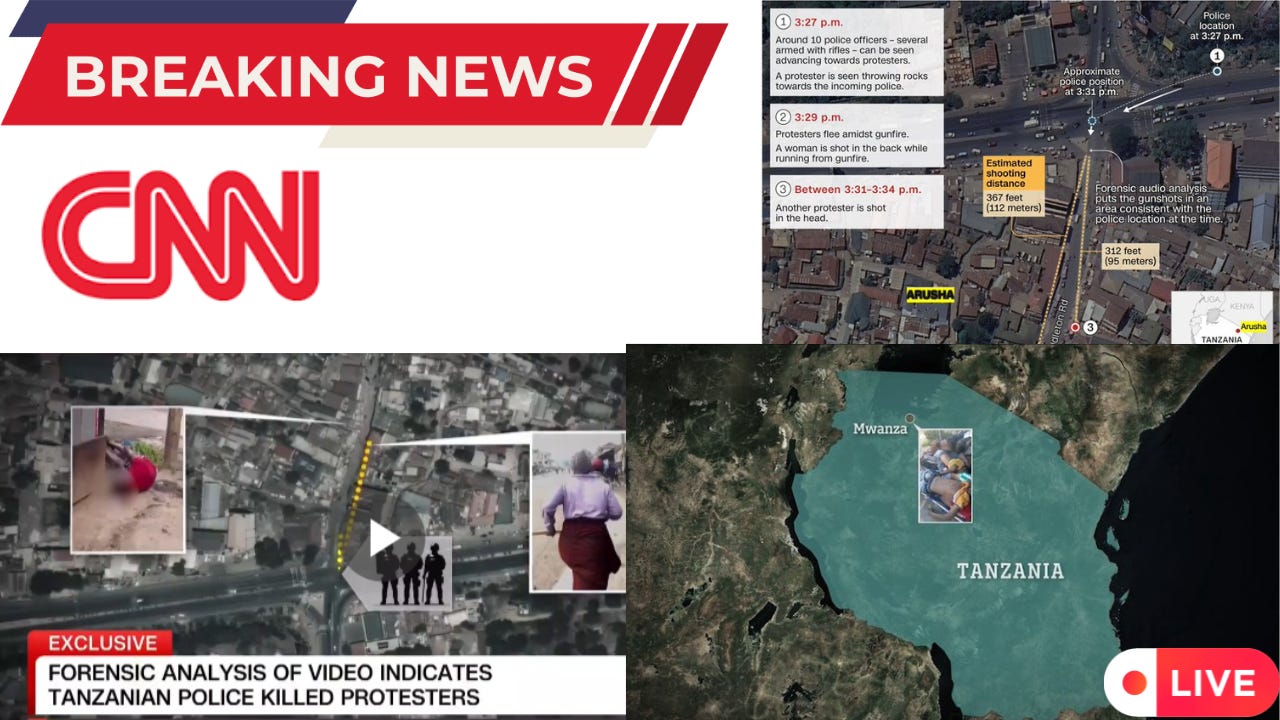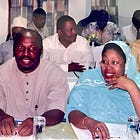CNN EXPOSES TANZANIA MASSACRE: Satellite Images Reveal Mass Graves, Morgues Overflow with Thousands Dead | Intelligence Assessment [FREE ACCESS]
🔓FREE ACCESS
Please consider becoming a paid subscriber
You can also donate.
Classification: Open Source Intelligence Assessment
Distribution: Public
Intelligence Cut-off Time: November 23, 2025 at 0735 GMT
Analyst: Ujasusi Blog’s East Africa Monitoring Team
📋 Executive Summary
On November 23, 2025, CNN published a landmark investigative report documenting systematic use of lethal force by Tanzanian security forces against protesters following the disputed October 29, 2025 presidential election. Using advanced OSINT methodologies including geolocation analysis, audio forensics, satellite imagery interpretation, and witness testimony corroboration, the investigation presents compelling evidence of:
Extrajudicial killings of protesters by uniformed police and plainclothes gunmen
Morgue overflow at multiple medical facilities across Tanzania
Mass graves at Kondo cemetery in Kunduchi, Dar es Salaam
Government denial operations and information suppression
Hundreds of civilian casualties according to UN Human Rights Office estimates
RELATED
This assessment analyses the intelligence and security implications of Tanzania’s post-election crisis, examines the OSINT methodologies employed in the investigation, evaluates the operational tactics of Tanzanian security forces, and assesses the strategic consequences for East African regional stability and Tanzania’s intelligence apparatus.
🗳️ Political Context: The Disputed October 2025 Election
Election Integrity Concerns
President Samia Suluhu Hassan claimed a landslide victory with 98% of the vote on October 29, 2025—a figure that immediately raised red flags among election observers and opposition parties. The election was fundamentally compromised before voting commenced: Hassan’s chief rivals were barred from the presidential race, eliminating meaningful electoral competition.
The main opposition leader, Tundu Lissu of the Chadema party, has been in custody since April 2025 and faces treason charges—a classic authoritarian tactic to neutralise political opposition before elections. Lissu was arrested after a rally in Mbinga and charged with treason over comments prosecutors claimed called for rebellion and disrupting the election. This pre-election detention of the primary opposition candidate represents a significant degradation of Tanzania’s democratic institutions.
Government Response Architecture
Following the election, Tanzanian authorities implemented a multi-layered information control operation:
Curfew imposition to restrict movement and assembly
Internet blackout to prevent real-time documentation and coordination
Media restrictions prohibiting sharing of photos/videos “that cause panic”
Official denial of protester killings initially
Belated acknowledgment without casualty figures
Counter-narrative deployment suggesting protesters were paid actors
President Hassan launched a commission on November 21, 2025 to investigate the unrest, but simultaneously undermined its credibility by suggesting protesters were financially motivated—a delegitimisation strategy commonly employed by authoritarian regimes facing popular unrest.
RELATED
🔍 OSINT Methodology: CNN’s Investigative Framework
The CNN investigation represents a sophisticated application of open-source intelligence tradecraft, demonstrating how OSINT techniques can penetrate government information denial operations. The methodology employed includes:
Geolocation Analysis
CNN partnered with open-source investigator Benjamin Strick to geolocate dozens of videos and images from protest scenes. Geolocation involves:
Matching visual landmarks in footage to satellite imagery
Identifying distinctive architectural features and street patterns
Verifying timestamps and shadow analysis for temporal confirmation
Cross-referencing multiple visual sources from the same location
The investigation successfully geolocated critical footage from:
Arusha intersection shootings
Mwananyamala Hospital morgue in Dar es Salaam
Sekou-Toure Regional Referral Hospital in Mwanza
Segerea and Ubungo areas in Dar es Salaam
Kondo cemetery mass grave site
Audio Forensic Analysis
Professor Rob Maher from Montana State University conducted forensic audio analysis of gunfire recorded in protest videos. This technique exploits the physics of ballistics:
The “crack” sound represents the ballistic shockwave of the bullet
The “boom” is the muzzle blast from the firearm
The time gap between these sounds calculates shooter-to-microphone distance
Maher established that:
The pregnant woman was shot from approximately 112 meters (367 feet)
The man with the head injury was at least 95 meters from police
These distances are critical intelligence indicators: they demonstrate that security forces were engaging targets at ranges where protesters posed no immediate physical threat to officers, undermining any potential self-defence justification.
Metadata Verification
CNN obtained original footage and analysed metadata to confirm authenticity and timing. Metadata analysis reveals:
Creation timestamps
Device information
Location data (if enabled)
Editing history
File modification records
Satellite Imagery Intelligence
The investigation utilised commercial satellite imagery from Planet Labs and Vantor (high-resolution) and Sentinel-2 (temporal analysis) to document ground disturbance at Kondo cemetery:
November 9 and 15 imagery showed disturbed ground in a barren 60-meter plot
Sentinel-2 temporal analysis narrowed the digging timeframe to November 2-5, 2025
The disturbed area was located near existing graves but previously undisturbed
This represents classic satellite intelligence collection for detecting clandestine burial operations.
RELATED
⚔️ Security Force Operations: Tactical Assessment
Use of Lethal Force
The CNN investigation documents multiple instances of disproportionate and unjustified lethal force:
Arusha Incident (October 29, 2025, 3:27 PM)
Target 1: Pregnant Woman
Status: Unarmed, fleeing, holding stick and rock
Engagement: Shot in the back while running away
Range: 112 meters
Outcome: Fatal, three months pregnant, survived by husband and two children
Tactical Assessment: No credible threat, execution-style engagement
Target 2: Young Male Protester
Status: Walking towards police position, not visibly armed at time of shooting
Engagement: Shot in the head
Range: 95+ meters
Outcome: Fatal
Tactical Assessment: Disproportionate force, no imminent threat
The Arusha shootings reveal several operational characteristics:
Lethal force as first response rather than crowd dispersal tactics
Engagement at distances precluding immediate threat
Targeting of fleeing individuals violating international norms
Head and torso shots indicating shoot-to-kill rather than incapacitation
Plainclothes Operations
Multiple videos document armed men in civilian clothing operating alongside uniformed police, deploying from white pickup trucks in Dar es Salaam neighbourhoods (Segerea area, Tabata Road, Ubungo). This operational pattern suggests:
Paramilitary formations or specialised police units
Deniability operations to obscure official responsibility
Intimidation tactics creating uncertainty about force composition
Coordination with uniformed officers indicating command integration
The use of plainclothes armed units is a hallmark of security services seeking plausible deniability while maintaining operational control. This mirrors tactics observed in other authoritarian crackdowns across Africa and globally.
💀 Casualty Assessment and Body Disposal Operations
Morgue Overflow Documentation
CNN verified footage from two major medical facilities:
Mwananyamala Hospital (Dar es Salaam):
Dozens of bodies covering morgue floor
Bodies piled on top of each other
Government denied authenticity via Ministry of Health statement
Family members identified relatives in footage
Sekou-Toure Regional Referral Hospital (Mwanza):
At least 10 bodies piled on stretchers outside facility
Doctor testimony: morgue filled, bodies then “piled outside”
Four-day treatment period for gunshot victims
Victims primarily young men with head, chest, abdomen, and limb wounds
An anonymous doctor’s testimony provides clinical intelligence:
“All had sustained gunshot wounds on different parts of the body. Especially the head, abdomen, chest, lower limbs. Badly wounded patients with varying degrees of consciousness.”
This injury pattern indicates centre-mass and head targeting—tactical shooting rather than warning shots or crowd control munitions.
RELATED
Mass Grave Operations
The Kondo cemetery evidence represents a potential body disposal operation to conceal casualty figures:
Location: Kunduchi, north of Dar es Salaam
Timeline: Digging occurred November 2-5, 2025 (4-6 days post-election)
Sources: Coalition of Tanzanian human rights groups, two local sources, CNN satellite analysis
Evidence: Recently disturbed soil in a 60-meter barren plot near existing graves
The timing is operationally significant: body disposal operations commenced within days of the election, suggesting pre-planned contingency operations for mass casualty scenarios.
Missing Bodies
Multiple families report inability to locate relatives’ bodies:
Viral Scout Management reported seven young soccer players killed, with six bodies unlocated
One woman identified her brother in Mwananyamala morgue footage after searching “every mortuary in Dar es Salaam”
Another brother’s body remains missing after being “shot dead at home in the Mara region”
This pattern suggests systematic body concealment operations beyond the documented mass grave, possibly including:
Multiple disposal sites
Immediate removal of bodies from killing scenes
Delayed or denied body release to families
Potential destruction of remains
📊 Casualty Estimates and Intelligence Gaps
UN Human Rights Office Assessment
The UN Human Rights Office, citing multiple sources in the country, suggested hundreds of protesters and civilians were killed, with unknown numbers injured or detained. This represents the most authoritative international estimate available.
UN Human Rights Chief Volker Türk urged investigations into the killings and other violations, noting reports that security forces transported bodies of those killed to undisclosed locations in an apparent attempt to conceal evidence.
Intelligence Assessment of Casualty Figures
High Confidence:
Dozens of confirmed deaths documented through visual evidence
Multiple morgues overwhelmed with bodies
Systematic use of lethal force across multiple cities
Medium Confidence:
Death toll in the hundreds based on UN sources and circumstantial evidence
Mass grave at Kondo cemetery contains protest victims
Additional undocumented burial sites exist
Low Confidence/Intelligence Gaps:
Precise casualty figures remain unknown
Full extent of detention operations unclear
Number and locations of all disposal sites are undetermined
The Tanzanian government’s refusal to release casualty figures represents an active intelligence denial operation, complicating accurate assessment.
🌍 Regional and International Implications
Tanzania’s Democratic Regression
This crisis marks a profound deterioration of Tanzania’s reputation as a stable democracy. The country, which attracts millions of tourists annually, has historically been viewed as a regional anchor of stability in East Africa. The systematic violence against protesters represents:
Democratic backsliding from previous electoral standards
Security sector impunity and lack of accountability mechanisms
Information control capabilities rivalling more repressive regional states
Potential precedent for future election cycles
Intelligence Service Assessment
The operations documented by CNN suggest coordination and planning at senior levels of Tanzania’s security apparatus:
Rapid deployment of lethal force across multiple cities simultaneously
Integrated operations between uniformed and plainclothes forces
Body disposal logistics require coordination and resources
Information suppression across multiple domains (internet, media, official statements)
This operational sophistication indicates pre-election planning for violent suppression of protests, rather than improvised responses to unexpected unrest.
East African Regional Security Architecture
Tanzania’s crisis has implications for regional stability:
SADC and EAC must now contend with democratic crisis in major member state
Refugee flows may increase if political violence continues
Regional intelligence cooperation complicated by Tanzania’s actions
Precedent effects for other nations facing electoral challenges
🎯 Methodological Lessons for Intelligence Analysts
The CNN investigation demonstrates the power of OSINT in penetrating state information denial operations:
Key Takeaways:
Commercial satellite imagery can document clandestine operations (mass graves)
Audio forensics provide objective evidence of engagement distances
Geolocation confirms ground truth despite government denials
Metadata analysis authenticates footage and timestamps
Cross-source corroboration (videos, witnesses, medical testimony) builds comprehensive picture
Open-source collaboration (Benjamin Strick, Professor Maher) enhances analytical capabilities
This case study should be integrated into OSINT training curricula for intelligence and human rights investigators globally.
📌 Conclusion: The Intelligence Assessment
Tanzania’s post-election violence represents a systematic security operation involving:
Premeditated use of lethal force against largely unarmed protesters
Multi-agency coordination between uniformed and plainclothes forces
Body disposal operations to conceal casualty figures
Comprehensive information control to suppress evidence
The CNN investigation, through sophisticated OSINT methodology, has penetrated Tanzania’s information denial operation and documented crimes that the government attempted to conceal. The evidence suggests that possible crimes against humanity warrant an international investigation.
For intelligence professionals and security analysts, this case illustrates both the operational sophistication of modern authoritarian crackdowns and the evolving capabilities of open-source intelligence in exposing state violence despite comprehensive information control efforts.
The strategic question remains: Will Tanzania face meaningful international accountability, or will this crisis become another documented but unpunished episode of state violence in Africa’s ongoing democratic struggles?
This assessment represents independent analysis based on open-source materials and does not constitute legal findings or official determinations.






